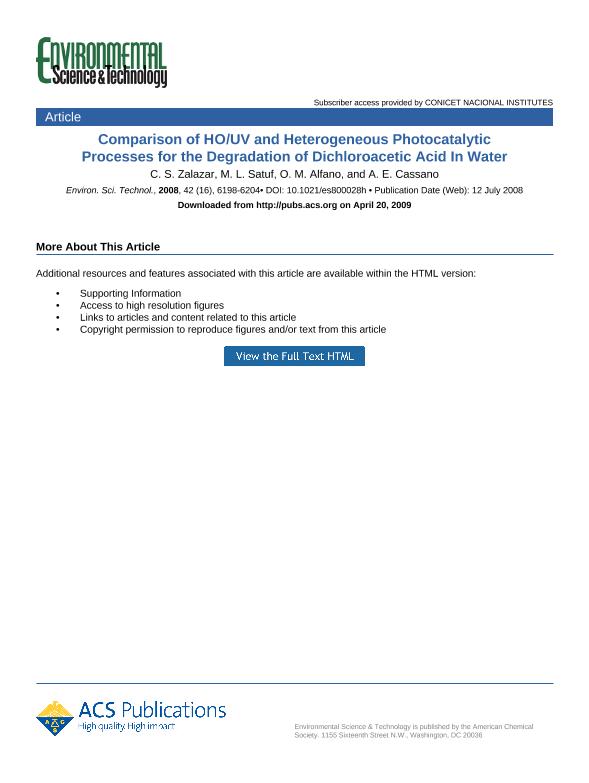Mostrar el registro sencillo del ítem
dc.contributor.author
Zalazar, Cristina Susana

dc.contributor.author
Satuf, María Lucila

dc.contributor.author
Alfano, Orlando Mario

dc.contributor.author
Cassano, Alberto Enrique

dc.date.available
2017-09-28T19:51:23Z
dc.date.issued
2008-12
dc.identifier.citation
Zalazar, Cristina Susana; Satuf, María Lucila; Alfano, Orlando Mario; Cassano, Alberto Enrique; Comparison of H2O2/UV and Heterogeneous Photocatalytic Processes for the Degradation of Dichloroacetic Acid in Water; American Chemical Society; Environmental Science & Technology; 42; 16; 12-2008; 6198-6204
dc.identifier.issn
0013-936X
dc.identifier.uri
http://hdl.handle.net/11336/25361
dc.description.abstract
A comparative study between two advanced oxidation technologies for pollutant degradation has been made. With the use of dichloroacetic acid (DCA) as the model pollutant, the reactions with hydrogen peroxide and UV radiation (H2O2/UV, 253.7 nm) and photocatalysis with titanium dioxide (TiO2/UV, 300-400 nm) are analyzed. Three criteria have been selected to compare the performances of both processes: (i) the percentage conversion of DCA and TOC (total organic carbon) at a fixed reaction time; (ii) the quantum efficiency, employing the true radiation absorption rates for both activated species (H2O2 and TiO2); (iii) the specific energy consumption to degrade 50% of the initial TOC. The optimal molar concentration ratio of H2O2/DCA and the optimal catalyst concentration have been employed in the experiments. The results indicate that, under the optimal operating conditions, theH2O2/UV process exhibits, by a large difference, the best performance taking into account the above-mentioned criteria. Nevertheless, both systems show similar values of specific energy consumption when a thinner reactor is employed. These results cannot be safely extrapolated to other contexts if (i) other compounds of different structure are degraded and (ii) a different catalyst is used. Moreover, theywereobtained under optimized conditions, and typical, real-life situations may render quite different results due to the robustness of the titanium dioxide operation. They should serve as an indication that, under the studied conditions, a much-improved catalyst performance must be achieved to parallel, with a heterogeneous process, a yield similar to the one obtained with the homogeneous system.
dc.format
application/pdf
dc.language.iso
eng
dc.publisher
American Chemical Society

dc.rights
info:eu-repo/semantics/openAccess
dc.rights.uri
https://creativecommons.org/licenses/by-nc-sa/2.5/ar/
dc.subject
Dichloroacetic Acid
dc.subject
Photocatalysis
dc.subject
Titanium Dioxide
dc.subject
Advanced Oxidation Technologies
dc.subject.classification
Otras Ingeniería Química

dc.subject.classification
Ingeniería Química

dc.subject.classification
INGENIERÍAS Y TECNOLOGÍAS

dc.title
Comparison of H2O2/UV and Heterogeneous Photocatalytic Processes for the Degradation of Dichloroacetic Acid in Water
dc.type
info:eu-repo/semantics/article
dc.type
info:ar-repo/semantics/artículo
dc.type
info:eu-repo/semantics/publishedVersion
dc.date.updated
2017-09-25T18:20:40Z
dc.journal.volume
42
dc.journal.number
16
dc.journal.pagination
6198-6204
dc.journal.pais
Estados Unidos

dc.description.fil
Fil: Zalazar, Cristina Susana. Consejo Nacional de Investigaciones Científicas y Técnicas. Centro Científico Tecnológico Conicet - Santa Fe. Instituto de Desarrollo Tecnológico para la Industria Química. Universidad Nacional del Litoral. Instituto de Desarrollo Tecnológico para la Industria Química; Argentina
dc.description.fil
Fil: Satuf, María Lucila. Consejo Nacional de Investigaciones Científicas y Técnicas. Centro Científico Tecnológico Conicet - Santa Fe. Instituto de Desarrollo Tecnológico para la Industria Química. Universidad Nacional del Litoral. Instituto de Desarrollo Tecnológico para la Industria Química; Argentina
dc.description.fil
Fil: Alfano, Orlando Mario. Consejo Nacional de Investigaciones Científicas y Técnicas. Centro Científico Tecnológico Conicet - Santa Fe. Instituto de Desarrollo Tecnológico para la Industria Química. Universidad Nacional del Litoral. Instituto de Desarrollo Tecnológico para la Industria Química; Argentina
dc.description.fil
Fil: Cassano, Alberto Enrique. Consejo Nacional de Investigaciones Científicas y Técnicas. Centro Científico Tecnológico Conicet - Santa Fe. Instituto de Desarrollo Tecnológico para la Industria Química. Universidad Nacional del Litoral. Instituto de Desarrollo Tecnológico para la Industria Química; Argentina
dc.journal.title
Environmental Science & Technology

dc.relation.alternativeid
info:eu-repo/semantics/altIdentifier/doi/http://dx.doi.org/10.1021/es800028h
dc.relation.alternativeid
info:eu-repo/semantics/altIdentifier/url/http://pubs.acs.org/doi/abs/10.1021/es800028h
Archivos asociados
